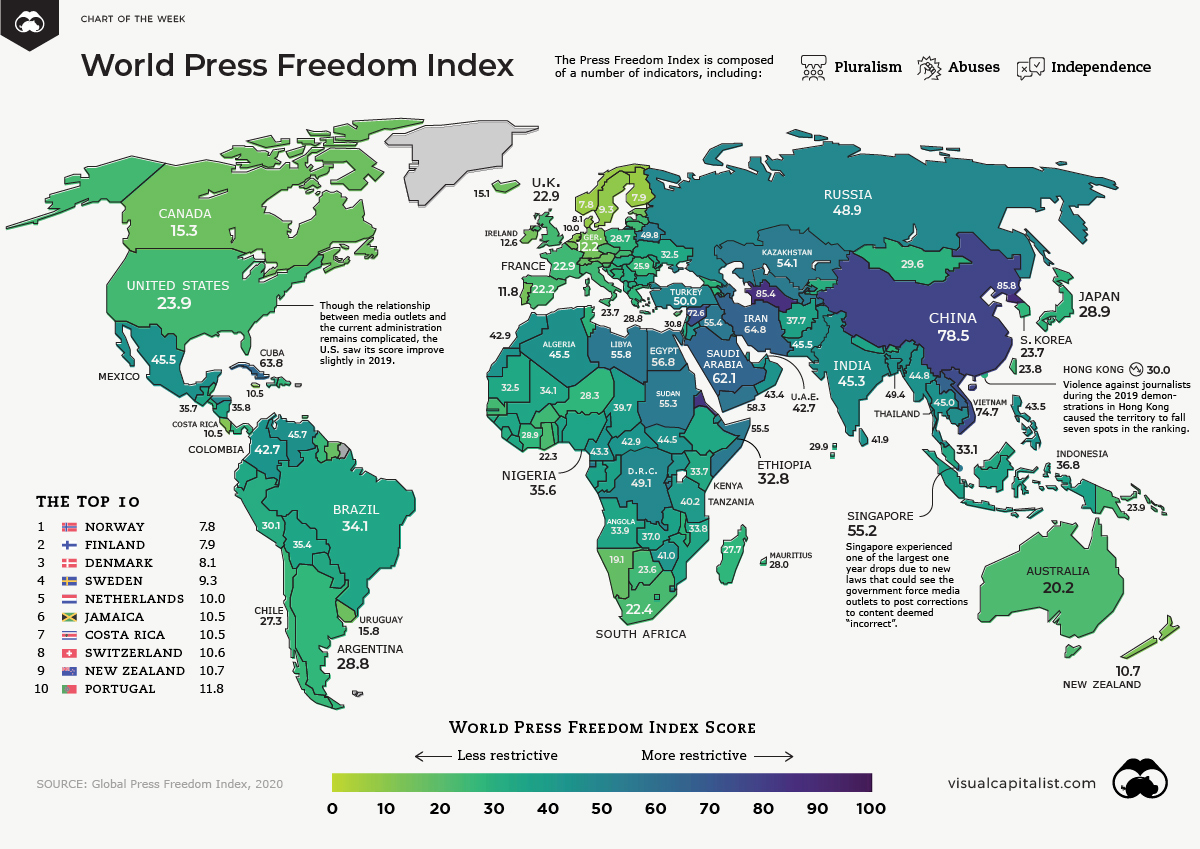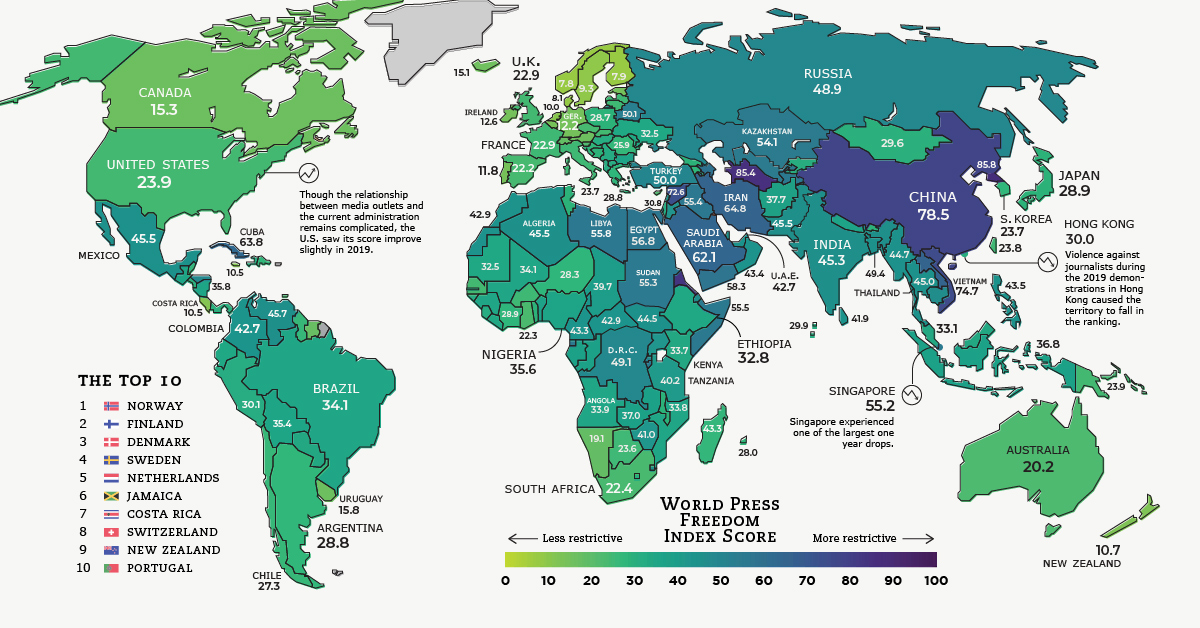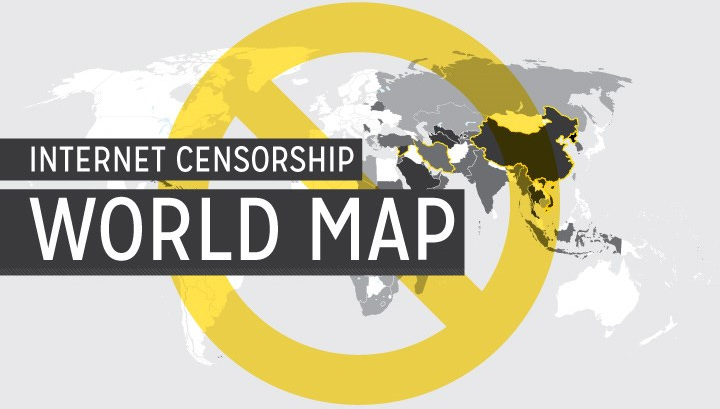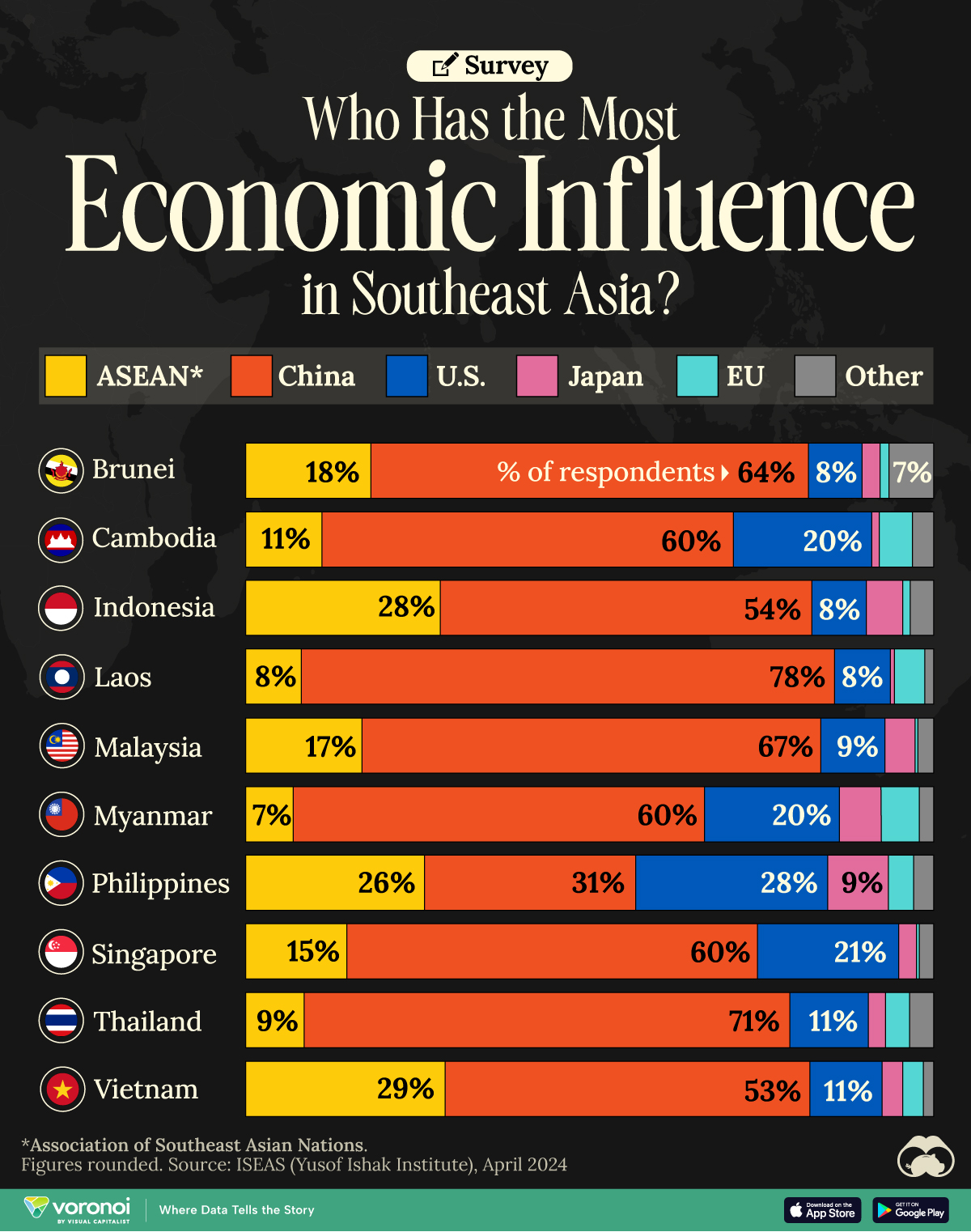Politics
Mapped: The State of Press Freedom Around the World
View a more detailed version of this map
Mapped: The State of Press Freedom Around the World
View a more detailed version of the above map by clicking here
In many Western countries, it’s easy to take press freedom for granted.
Instances of fake news, clickbait, and hyper-partisan reporting are points of consternation in the modern media landscape, and can sometimes overshadow the greater good that unrestricted journalism provides to society.
Of course, the ability to do that important work can vary significantly around the world. Being an investigative journalist in Sweden comes with a very different set of circumstances and considerations than doing the same thing in a country such as Saudi Arabia or Venezuela.
Today’s map highlights the results of the 2020 Global Press Freedom Index, produced by Reporters Without Borders. The report looks at press freedom in 180 countries and territories.
A Profession Not Without Its Risks
Today, nearly 75% of countries are in categories that the report describes as problematic, difficult, and very serious.
While these negative forces often come in the form of censorship and intimidation, journalism can be a risky profession in some of the more restrictive countries. One example is Mexico, where nearly 60 journalists were killed as a direct result of their reporting over the last decade.
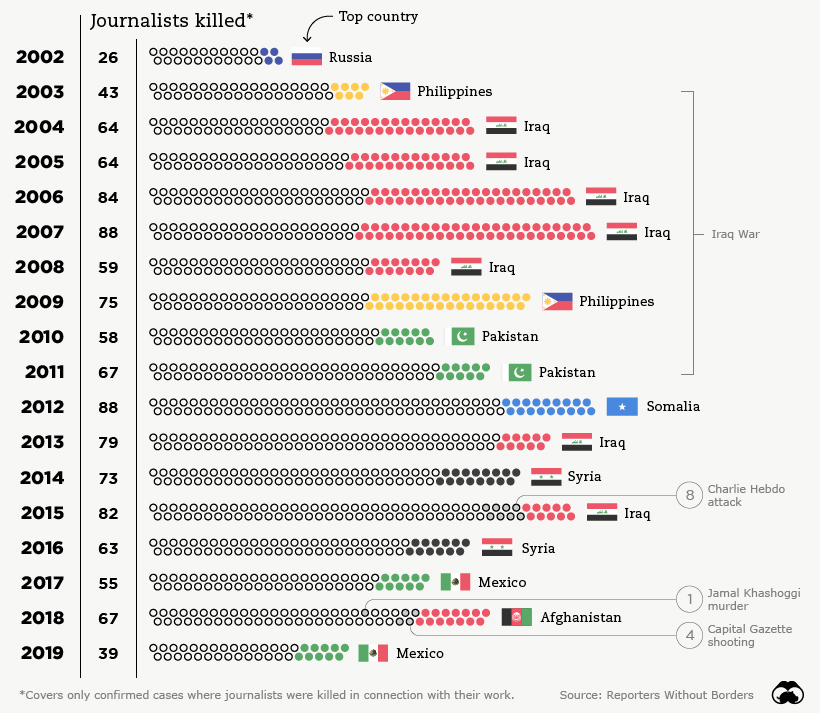
There is good news though: the number of journalists killed last year was the lowest since the report began in 2002.
Even better, press freedom scores increased around the world in the 2020 report.
Press Freedom: The Good, The Bad, The Ugly
Here are the scores for all 180 countries and territories covered in the report, sorted by 2020 ranking and score:
| Rank (2020) | Country or Region | Score (2020) | Prev. Rank (2019) | Change in Rank |
|---|---|---|---|---|
| #1 | 🇳🇴 Norway | 7.84 | 1 | 0 |
| #2 | 🇫🇮 Finland | 7.93 | 2 | 0 |
| #3 | 🇩🇰 Denmark | 8.13 | 5 | 2 |
| #4 | 🇸🇪 Sweden | 9.25 | 3 | -1 |
| #5 | 🇳🇱 Netherlands | 9.96 | 4 | -1 |
| #6 | 🇯🇲 Jamaica | 10.51 | 8 | 2 |
| #7 | 🇨🇷 Costa Rica | 10.53 | 10 | 3 |
| #8 | 🇨🇭 Switzerland | 10.62 | 6 | -2 |
| #9 | 🇳🇿 New Zealand | 10.69 | 7 | -2 |
| #10 | 🇵🇹 Portugal | 11.83 | 12 | 2 |
| #11 | Germany | 12.16 | 13 | 2 |
| #12 | Belgium | 12.57 | 9 | -3 |
| #13 | Ireland | 12.60 | 15 | 2 |
| #14 | Estonia | 12.61 | 11 | -3 |
| #15 | Iceland | 15.12 | 14 | -1 |
| #16 | Canada | 15.29 | 18 | 2 |
| #17 | Luxembourg | 15.46 | 17 | 0 |
| #18 | Austria | 15.78 | 16 | -2 |
| #19 | Uruguay | 15.79 | 19 | 0 |
| #20 | Suriname | 17.50 | 20 | 0 |
| #21 | Samoa | 18.25 | 22 | 1 |
| #22 | Latvia | 18.56 | 24 | 2 |
| #23 | Namibia | 19.25 | 23 | 0 |
| #24 | Liechtenstein | 19.52 | 26 | 2 |
| #25 | Cape Verde | 20.15 | 25 | 0 |
| #26 | Australia | 20.21 | 21 | -5 |
| #27 | Cyprus | 20.45 | 28 | 1 |
| #28 | Lithuania | 21.19 | 30 | 2 |
| #29 | Spain | 22.16 | 29 | 0 |
| #30 | Ghana | 22.26 | 27 | -3 |
| #31 | South Africa | 22.41 | 31 | 0 |
| #32 | Slovenia | 22.64 | 34 | 2 |
| #33 | Slovakia | 22.67 | 35 | 2 |
| #34 | France | 22.92 | 32 | -2 |
| #35 | United Kingdom | 22.93 | 33 | -2 |
| #36 | Trinidad and Tobago | 23.22 | 39 | 3 |
| #37 | Andorra | 23.23 | 37 | 0 |
| #38 | Burkina Faso | 23.47 | 36 | -2 |
| #39 | Botswana | 23.56 | 44 | 5 |
| #40 | Czech Republic | 23.57 | 40 | 0 |
| #41 | Italy | 23.69 | 43 | 2 |
| #42 | South Korea | 23.70 | 41 | -1 |
| #43 | Taiwan | 23.76 | 42 | -1 |
| #44 | OECS | 23.78 | 50 | 6 |
| #45 | United States | 23.85 | 48 | 3 |
| #46 | Papua New Guinea | 23.93 | 38 | -8 |
| #47 | Senegal | 23.99 | 49 | 2 |
| #48 | Romania | 25.91 | 47 | -1 |
| #49 | Guyana | 26.63 | 51 | 2 |
| #50 | Tonga | 27.27 | 45 | -5 |
| #51 | Chile | 27.31 | 46 | -5 |
| #52 | Fiji | 27.41 | 52 | 0 |
| #53 | Belize | 27.50 | 53 | 0 |
| #54 | Madagascar | 27.68 | 54 | 0 |
| #55 | Dominican Republic | 27.90 | 55 | 0 |
| #56 | Mauritius | 28.00 | 58 | 2 |
| #57 | Niger | 28.25 | 66 | 9 |
| #58 | Bosnia and Herzegovina | 28.51 | 63 | 5 |
| #59 | Croatia | 28.51 | 64 | 5 |
| #60 | Georgia | 28.59 | 60 | 0 |
| #61 | Armenia | 28.60 | 61 | 0 |
| #62 | Poland | 28.65 | 59 | -3 |
| #63 | Seychelles | 28.66 | 69 | 6 |
| #64 | Argentina | 28.78 | 57 | -7 |
| #65 | Greece | 28.80 | 65 | 0 |
| #66 | Japan | 28.86 | 67 | 1 |
| #67 | Bhutan | 28.90 | 80 | 13 |
| #68 | Ivory Coast | 28.94 | 71 | 3 |
| #69 | Malawi | 29.32 | 68 | -1 |
| #70 | Kosovo | 29.33 | 75 | 5 |
| #71 | Togo | 29.33 | 76 | 5 |
| #72 | Tunisia | 29.45 | 72 | 0 |
| #73 | Mongolia | 29.61 | 70 | -3 |
| #74 | El Salvador | 29.70 | 81 | 7 |
| #75 | Comoros | 29.77 | 56 | -19 |
| #76 | Panama | 29.78 | 79 | 3 |
| #77 | Cyprus North | 29.79 | 74 | -3 |
| #78 | East Timor | 29.90 | 84 | 6 |
| #79 | Maldives | 29.93 | 98 | 19 |
| #80 | Hong Kong | 30.01 | 73 | -7 |
| #81 | Malta | 30.16 | 77 | -4 |
| #82 | Kyrgyzstan | 30.19 | 83 | 1 |
| #83 | Haiti | 30.20 | 62 | -21 |
| #84 | Albania | 30.25 | 82 | -2 |
| #85 | Sierra Leone | 30.28 | 86 | 1 |
| #86 | Lesotho | 30.45 | 78 | -8 |
| #87 | Gambia | 30.62 | 92 | 5 |
| #88 | Israel | 30.84 | 88 | 0 |
| #89 | Hungary | 30.84 | 87 | -2 |
| #90 | Peru | 30.94 | 85 | -5 |
| #91 | Moldova | 31.16 | 91 | 0 |
| #92 | Macedonia | 31.28 | 95 | 3 |
| #93 | Serbia | 31.62 | 90 | -3 |
| #94 | Guinea-Bissau | 32.06 | 89 | -5 |
| #95 | Liberia | 32.25 | 93 | -2 |
| #96 | Ukraine | 32.52 | 102 | 6 |
| #97 | Mauritania | 32.54 | 94 | -3 |
| #98 | Ecuador | 32.62 | 97 | -1 |
| #99 | Ethiopia | 32.82 | 110 | 11 |
| #100 | Paraguay | 32.97 | 99 | -1 |
| #101 | Malaysia | 33.12 | 123 | 22 |
| #102 | Lebanon | 33.19 | 101 | -1 |
| #103 | Kenya | 33.72 | 100 | -3 |
| #104 | Mozambique | 33.79 | 103 | -1 |
| #105 | Montenegro | 33.83 | 104 | -1 |
| #106 | Angola | 33.92 | 109 | 3 |
| #107 | Brazil | 34.05 | 105 | -2 |
| #108 | Mali | 34.12 | 112 | 4 |
| #109 | Kuwait | 34.30 | 108 | -1 |
| #110 | Guinea | 34.34 | 107 | -3 |
| #111 | Bulgaria | 35.06 | 111 | 0 |
| #112 | Nepal | 35.10 | 106 | -6 |
| #113 | Benin | 35.11 | 96 | -17 |
| #114 | Bolivia | 35.37 | 113 | -1 |
| #115 | Nigeria | 35.63 | 120 | 5 |
| #116 | Guatemala | 35.74 | 116 | 0 |
| #117 | Nicaragua | 35.81 | 114 | -3 |
| #118 | Congo | 36.56 | 117 | -1 |
| #119 | Indonesia | 36.82 | 124 | 5 |
| #120 | Zambia | 37.00 | 119 | -1 |
| #121 | Gabon | 37.20 | 115 | -6 |
| #122 | Afghanistan | 37.70 | 121 | -1 |
| #123 | Chad | 39.70 | 122 | -1 |
| #124 | Tanzania | 40.25 | 118 | -6 |
| #125 | Uganda | 40.95 | 125 | 0 |
| #126 | Zimbabwe | 40.95 | 127 | 1 |
| #127 | Sri Lanka | 41.94 | 126 | -1 |
| #128 | Jordan | 42.08 | 130 | 2 |
| #129 | Qatar | 42.51 | 128 | -1 |
| #130 | Colombia | 42.66 | 129 | -1 |
| #131 | United Arab Emirates | 42.69 | 133 | 2 |
| #132 | C.A.R. | 42.87 | 145 | 13 |
| #133 | Morocco | 42.88 | 135 | 2 |
| #134 | Cameroon | 43.28 | 131 | -3 |
| #135 | Oman | 43.42 | 132 | -3 |
| #136 | Philippines | 43.54 | 134 | -2 |
| #137 | Palestine | 44.09 | 137 | 0 |
| #138 | South Sudan | 44.49 | 139 | 1 |
| #139 | Myanmar | 44.77 | 138 | -1 |
| #140 | Thailand | 44.94 | 136 | -4 |
| #141 | Swaziland | 45.15 | 147 | 6 |
| #142 | India | 45.33 | 140 | -2 |
| #143 | Mexico | 45.45 | 144 | 1 |
| #144 | Cambodia | 45.46 | 143 | -1 |
| #145 | Pakistan | 45.52 | 142 | -3 |
| #146 | Algeria | 45.52 | 141 | -5 |
| #147 | Venezuela | 45.66 | 148 | 1 |
| #148 | Honduras | 48.20 | 146 | -2 |
| #149 | Russian Federation | 48.92 | 149 | 0 |
| #150 | Congo (DRC) | 49.09 | 154 | 4 |
| #151 | Bangladesh | 49.37 | 150 | -1 |
| #152 | Brunei | 49.65 | 152 | 0 |
| #153 | Belarus | 49.75 | 153 | 0 |
| #154 | Turkey | 50.02 | 157 | 3 |
| #155 | Rwanda | 50.34 | 155 | 0 |
| #156 | Uzbekistan | 53.07 | 160 | 4 |
| #157 | Kazakhstan | 54.11 | 158 | 1 |
| #158 | Singapore | 55.23 | 151 | -7 |
| #159 | Sudan | 55.33 | 175 | 16 |
| #160 | Burundi | 55.33 | 159 | -1 |
| #161 | Tajikistan | 55.34 | 161 | 0 |
| #162 | Iraq | 55.37 | 156 | -6 |
| #163 | Somalia | 55.45 | 164 | 1 |
| #164 | Libya | 55.77 | 162 | -2 |
| #165 | Equatorial Guinea | 56.38 | 165 | 0 |
| #166 | Egypt | 56.82 | 163 | -3 |
| #167 | Yemen | 58.25 | 168 | 1 |
| #168 | Azerbaijan | 58.48 | 166 | -2 |
| #169 | Bahrain | 60.13 | 167 | -2 |
| #170 | Saudi Arabia | 62.14 | 172 | 2 |
| #171 | Cuba | 63.81 | 169 | -2 |
| #172 | Laos | 64.28 | 171 | -1 |
| #173 | Iran | 64.81 | 170 | -3 |
| #174 | Syria | 72.57 | 174 | 0 |
| #175 | Vietnam | 74.71 | 176 | 1 |
| #176 | Djibouti | 76.73 | 173 | -3 |
| #177 | China | 78.48 | 177 | 0 |
| #178 | Eritrea | 83.50 | 178 | 0 |
| #179 | Turkmenistan | 85.44 | 180 | 1 |
| #180 | North Korea | 85.82 | 179 | -1 |
Which countries stood out in this year’s edition of the press freedom rankings?
Norway: Nordic Countries have topped the Press Freedom Index since its inception, and Norway (Rank: #1) in particular is an example for the world. Despite a very free media environment, the government recently mandated a commission to conduct a comprehensive review of the conditions for freedom of speech. Members will consider measures to promote the broadest possible participation in the public debate, and means to hamper the spread of fake news and hate speech.
Malaysia: A new government ushered in a less restrictive era in Malaysia in 2018. Journalists and media outlets that had been blacklisted were able to resume working, and anti-fake news laws that were viewed as problematic were repealed. As a result, Malaysia’s index score has improved by 15 points in the past two years. This is in sharp contrast to neighbor, Singapore, which is ranked 158th out of 180 countries.
Ethiopia: When Abiy Ahmed Ali took power in Africa’s second most populous country in 2018, his government restored access to over 200 news websites and blogs that had been previously blocked. As well, many detained journalists and bloggers were released as the chill over the country’s highly restrictive media environment began to thaw. As a result, Ethiopia (#99) jumped up eleven spots in the Press Freedom Index in 2020.
The Middle East: Though the situation in this region has begun to stabilize somewhat, restrictions still remain – even in relatively safe and stable countries. Both Saudi Arabia (#170) and Egypt (#166) have imprisoned a number of journalists in recent years, and the former is still dealing with the reputational fallout from the assassination of Saudi dissident and Washington Post columnist, Jamal Khashoggi.
China: Sitting near the bottom of the list is China (#176). More than 100 journalists and bloggers are currently detained as the country maintains a tight grip over the press – particularly as COVID-19 began to spread. Earlier this year, the Chinese government also expelled over a dozen journalists representing U.S. publications.
2020: A Pivotal Year for the Press
As the world grapples with a deadly pandemic, a global economic shutdown, and a crucial election year, the media could find itself in the spotlight more than in previous years.
How the stories of 2020 are told will influence our collective future – and how regimes choose to treat journalists under this atypical backdrop will tell us a lot about press freedom going forward.
China
Which Countries Have the Most Economic Influence in Southeast Asia?
One country dominates this survey of who has the most economic influence in the region.
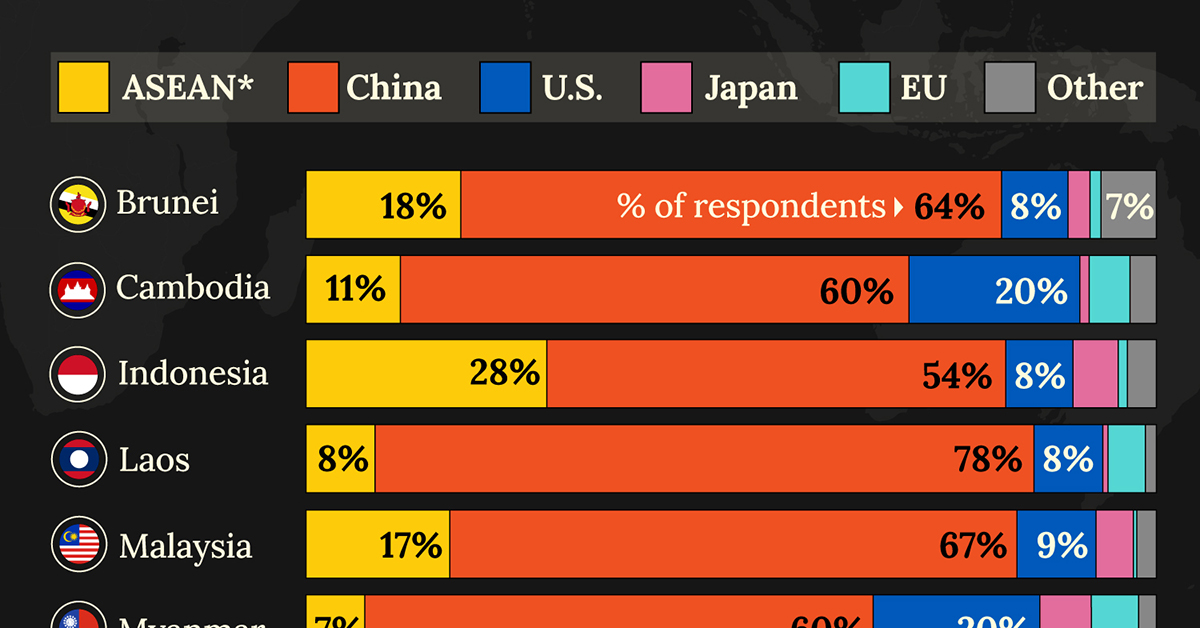
Countries With the Most Economic Influence in Southeast Asia
This was originally posted on our Voronoi app. Download the app for free on iOS or Android and discover incredible data-driven charts from a variety of trusted sources.
This chart visualizes the results of a 2024 survey conducted by the ASEAN Studies Centre at the ISEAS-Yusof Ishak Institute.
Nearly 2,000 respondents from 10 countries were asked to select which country/region they believe has the most influential economic power in Southeast Asia.
The countries surveyed are all member states of the Association of Southeast Asian Nations (ASEAN), a political and economic union of 10 countries in Southeast Asia.
Southeast Asia Perceptions: Who’s Got Economic Influence?
Across all ASEAN nations, China is regarded as the region’s most influential economic power.
Laos and Thailand had the highest share of respondents picking China, at 78% and 71% respectively. As the report points out, China is Laos’ largest foreign investor as well as its top export market.
| Country | 🇨🇳 China | 🌏 ASEAN | 🇺🇸 U.S. |
|---|---|---|---|
| 🇧🇳 Brunei | 64% | 18% | 8% |
| 🇰🇭 Cambodia | 60% | 11% | 20% |
| 🇮🇩 Indonesia | 54% | 28% | 8% |
| 🇱🇦 Laos | 78% | 8% | 8% |
| 🇲🇾 Malaysia | 67% | 17% | 9% |
| 🇲🇲 Myanmar | 60% | 7% | 20% |
| 🇵🇭 Philippines | 31% | 26% | 28% |
| 🇸🇬 Singapore | 60% | 15% | 21% |
| 🇹🇭 Thailand | 71% | 9% | 11% |
| 🇻🇳 Vietnam | 53% | 29% | 11% |
Note: Percentages are rounded.
Other ASEAN countries usually score highly as well, along with the United States.
It’s only in the Philippines, where China (31%), the U.S. (28%) and ASEAN (26%) were perceived as having a similar amount of influence.
ASEAN, Japan, and the EU
Filipinos also rated Japan’s economic influence the highest (9%) compared to those surveyed in other ASEAN countries. In 2023, the Southeast Asian bloc celebrated 50 years of friendship with Japan, marking it as one of their most important “dialogue partners.”
| Country | 🇯🇵 Japan | 🇪🇺 EU | 🌐 Other |
|---|---|---|---|
| 🇧🇳 Brunei | 3% | 1% | 7% |
| 🇰🇭 Cambodia | 1% | 5% | 3% |
| 🇮🇩 Indonesia | 5% | 1% | 3% |
| 🇱🇦 Laos | 1% | 4% | 1% |
| 🇲🇾 Malaysia | 4% | 0% | 2% |
| 🇲🇲 Myanmar | 6% | 6% | 2% |
| 🇵🇭 Philippines | 9% | 4% | 3% |
| 🇸🇬 Singapore | 3% | 0% | 2% |
| 🇹🇭 Thailand | 3% | 4% | 4% |
| 🇻🇳 Vietnam | 3% | 3% | 2% |
Note: Percentages are rounded. Other countries include: Australia, South Korea, India, and the UK.
The EU also received single-percentage responses, its highest share coming from Myanmar (6%), Cambodia (5%), and Laos (4%).
Finally, the report contrasted China’s robust economic influence with concerns about its growing impact in the region. Respondents from Vietnam (88%), Myanmar (88%), and Thailand (80%) had the highest levels of concern, despite their countries’ strong trade ties with China.
-

 Technology1 week ago
Technology1 week agoCountries With the Highest Rates of Crypto Ownership
-

 Mining6 days ago
Mining6 days agoVisualizing Copper Production by Country in 2023
-

 Politics7 days ago
Politics7 days agoCharted: How Americans Feel About Federal Government Agencies
-

 Healthcare1 week ago
Healthcare1 week agoWhich Countries Have the Highest Infant Mortality Rates?
-

 Demographics1 week ago
Demographics1 week agoMapped: U.S. Immigrants by Region
-

 Economy1 week ago
Economy1 week agoMapped: Southeast Asia’s GDP Per Capita, by Country
-

 Automotive1 week ago
Automotive1 week agoHow People Get Around in America, Europe, and Asia
-

 Personal Finance1 week ago
Personal Finance1 week agoVisualizing the Tax Burden of Every U.S. State

